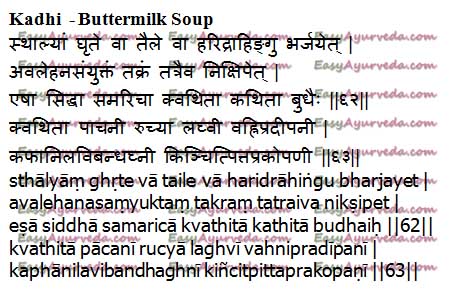Kadhi Buttermilk soup: Ayurvedic Method Of Making, Health Benefits
By Dr M S Krishnamurthy MD(Ayu), PhD.
Among the side dishes and gravy preparations age old classical recipes are declining in recent years. Instead, new and tasty preparations are taking top position in the Menu card. Sambhar, Soup, curry, chutney etc are the classical food recipes for which another significant preparation enrolled in centuries back itself was – Khadi or Kadhi.
As per the ingredients added Dal khadi, Cchas khadi, Dahi kadhi, Shak khadi are prepared by adding Dal (pulses), buttermilk, curd and vegetables respectively.
The classical preparation Khadi is explained in Ayurvedic text Bhavaprakasha is as follows –
Table of Contents
Classical reference

Reference: Bhavaprakasha nighantu – Kritanna varga/62-63
Khadi as per Ayurveda
What is Khadi as per Ayurvedic dietetics?
In a metallic pan turmeric powder and asafetida are taken and fried with ghee or oil. To this fine paste of yellow gram (tuvaree) flour (macerated yellow gram can be added otherwise) is added and by adding water to this it is cooked well. Further buttermilk, quantity sufficient salt and pepper are also added and boiled.
Once boiling, this is taken out and served. It is called Khadi or Kwathita.
Qualities, actions, applications
Qualities of buttermilk soup –
Light for digestion, pacifier of Kapha and Vata dosha. It is unctuous, stable and mild motile (kinchit sara)
Action: It is digestive, appetizer, carminative, laxative and mild aggravating of Pitta dosha.
Application:
As it is light and carminative, it can be advised in abdominal distension, indigestion, constipation, haemorroids, Irritable bowel syndrome, anal fissure, abdominal pain etc. As Kadhi balances Vata and Kapha, it can be given to asthmatic patients and to the patients of cold and cough too. But in such patients it is advised only during day time and not in night as it may worsen Kapha during night.
Kadhi can be advised in all age group. But, during Autumn season it is wise to avoid as it may aggravate pitta during n this season. As per ones desire cooked vegetables can also be added to the Khadi. Such preparations will possess the qualities of those added vegetables too.
Due to the above said qualities and benefits Khadi has wide scope in incorporation in the hospital kitchens.
Click to consult Dr MS Krishnamurthy MD (Ayu), PhD









8 comments on “Kadhi Buttermilk soup: Ayurvedic Method Of Making, Health Benefits”
Kristina
Dear sir, do you have any writings about nuts when they come in contact with metal, as when blending them, whether they are useful for us or they very quickly oxidized and become to much acid? Thank you, I know this question is not connect with the above.
Dr J V Hebbar MD(Ayu)
I have not written about it. Needs a bit of research. Will try to cover it in future.
Gaurav
Good to know that Kadhi is mentioned in references as being an acceptable preparation, otherwise I was almost beginning to think that since buttermilk is boiled, it must be the concoction of an ayurveda-ignorant mind!
Rachana Ch
Can buttermilk be heated?
Dr J V Hebbar MD(Ayu)
Yes
Avinash kaur
Hello Sir,
Though curd is prepared from the boiled milk, then again the product ‘curd’ is heated for making kadhi, is this right to reheat for cooking?
Regards,
Avinash Kaur
Dr J V Hebbar MD(Ayu)
Heating of curd is not recommended in Ayurveda
Simran
Kadhi should be prepared from buttermilk not curd. Buttermilk can be heated but not curd